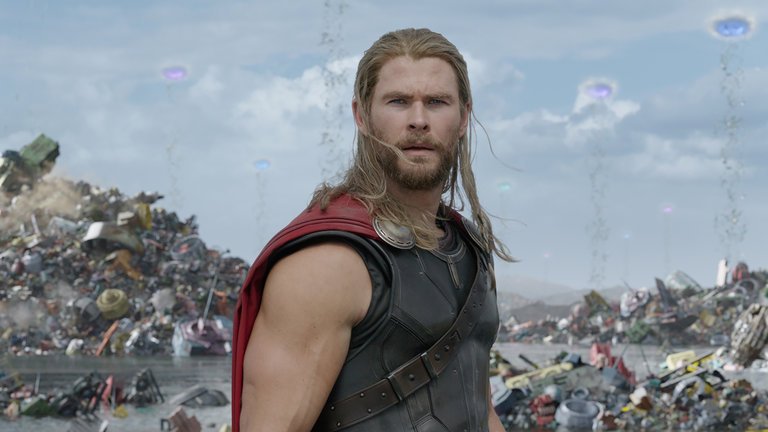
There’s a nice bit in “Thor: Ragnarok,” the latest Marvel blowout to feature the god of thunder, where he tries to start a jet using a voice-activated password. He needs to make a getaway — he’s neck deep in trouble and plot entanglements — so identifies himself as the “strongest Avenger.” No dice. Given his earlier stand-alone movies, Thor might have had better luck cracking the code if he’d copped to being the “most boring Avenger.”
Through no fault of their likable star, Chris Hemsworth, the Thor movies have been largely forgettable, memorable mostly for the upstaging antics of his brother, Loki (Tom Hiddleston), and as a bad fit for Natalie Portman (Thor’s former love interest, now mercifully banished into the storytelling cornfield). “Ragnarok” tries hard to change that profile, and mostly succeeds by knocking its big, blond beauty consistently down to size. It makes sense for all sorts of reasons, including that superheroes can so easily appear to be on the wrong side of history, especially those who look like Aryan cartoons.
That isn’t Thor’s fault; he was drawn that way. But times change, and a conceptual makeover was necessary — and not just to boost his box-office appeal. Marvel could have gone grimmer, broodier and sterner, but that isn’t its onscreen way; so it has made Thor sunnier, sillier and funnier. It’s a good fit, at least for a while. Like some other superheroes, Thor has been good for the occasional light, mocking laugh, often hooked to his otherworldly identity: He’s a god (as he likes to announce), son of Odin (Anthony Hopkins), and so forth. For much of “Ragnarok,” he’s a playfully sustained joke.
As a storyteller, the director Taika Waititi (“Hunt for the Wilderpeople”) has a charmingly idiosyncratic human touch and a gift for turning goofiness and gab into personality. That gift is first evident here in the intimate huddles between Thor and whoever happens to be within chatting (or shouting) distance. There’s a lot of yakking, some barking; at one point, Odin does some god-splaining. The Chatty Cathies also include Thor’s sister, Hela (a vamping Cate Blanchett), an overgrown Goth Girl with smudged eye makeup and killer dominatrix looks who plays very hard. She lusts for Odin’s realm, which remains as drearily amorphous and anonymous as before.
The story is an uninteresting thicket of brawls, machinations and useful coincidences. (Eric Pearson, Craig Kyle and Christopher Yost wrote the screenplay.) Soon after Hela appears, she moves back home and Thor lands elsewhere, allowing her to run amok — kill, strut, repeat — and him to leisurely settle into his new, more lighthearted mode until it’s serious hammer time. Much of his great un-Thoring happens on Sakaar, a planetary garbage dump run by the Grandmaster (Jeff Goldblum, comically jiving and dithering), a psychopath Auntie Mame in flowing gold lamé and blue fingernail polish who suggests a low-rent version of Stanley Tucci’s host in “The Hunger Games.”
The Grandmaster presides over a gladiatorial game, an exasperatingly lazy and uninteresting story development that is mostly (mostly) alleviated by Mr. Waititi’s handling of the material. It’s here that the vibe relaxes and the picture’s filigree becomes brighter and wittier as extras with puffball hairdos straight out of Dr. Seuss light up the background. It’s also here that Thor reunites with the Hulk, who’s been crushing the gladiatorial competition on an extended incredible bender. After he and Thor engage in some Steinbeckian George-and-Lennie riffing, the Hulk’s inner mouse, Bruce Banner, takes over, and Mark Ruffalo eases in to help turn the temperature from hot to cozy.
Mr. Hemsworth looks happier and far more relaxed in “Ragnarok” than he did in the previous Thor vehicles, which is perhaps Mr. Waititi’s truest achievement here. For a guy who looks chiseled by Michelangelo, Mr. Hemsworth can be a surprisingly agile physical performer, capable of real bounce, and he clearly likes ricocheting off walls as much as he does ceding center stage to the other actors. These include Tessa Thompson as Valkyrie, who, after an unpromising entrance, develops into a real character with emotion and an all-too-brief flashback filled with fury, beauty, liquid motion and mythological mystery.
Continue reading the main story
That scene is a jolt, because it’s a reminder of the narrative ambition and mythic grandeur that’s often reduced in this franchise to epic fights, fancy elocution and special effects. It’s amusing how “Ragnarok” humanizes Thor, yet in doing so it dilutes his Thorness, the essential qualities that make him more than a dude with a cool hammer. And the more familiar and less godlike he becomes, the more evident it is that this series has never figured out how to make his myth fit with the modern world. So it’s made Thor a fish out of water and a recurrent punch line. Now, though, with Thor (and Mr. Hemsworth) at last settled in, what he needs is a myth as mighty as his shtick.
Hi! I am a robot. I just upvoted you! I found similar content that readers might be interested in:
https://www.nytimes.com/2017/11/01/movies/thor-ragnarok-review-chris-hemsworth.html